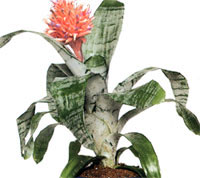Ehmeya / aechmea
Refers to the family of bromeliads. Fatherland Central and South America.
General description: Ehmeya is a typical bromeliad plant. She owns a well-defined funnel of leathery curved leaves, from the middle of which grows a healthy flower spike, crowned with a beautiful inflorescence.
Usually in the room conditions the following species are bred:
Aechmea fulgens discolor (Ehmeya glittering) is an epiphytic plant. Leaves on the lower side of purple, length about 70 cm, width about 7 cm. Cvetonos owns pubescence. The inflorescence is a panicle of purple small flowers. Fruits red berries.
Aechmea caudata (Ehmeya caudate) - epiphytic plant, owns a paniculate inflorescence with yellow flowers, eventually acquiring a purple hue. Colored leaves are red.
Aechmea fasciata (Ehmeya striped) is like an epiphytic plant. Leaves up to 1 m long have a dentate margin. The leaf paint is gray-green with transverse bands. The bands consist of small scales, with which the plant collects moisture, so it is impossible to wipe the leaves with a damp cloth to avoid damaging them. Has a head inflorescence on a densely pubescent peduncle. Pink-red bracts up to 12 cm long hide small blue flowers.
Recommendations for caring for the plant Ehmeya:
Illumination : Needs bright, but diffused light. For variegated forms, shading only in the summer noon.
Irrigation mode : The socket should be filled with soft warm water for 3 cm, water should be changed every 3 weeks, the soil should always be moist.
Humidity : Adores high humidity, often sprinkle with warm water from a shallow atomizer.
Temperature regime : Optimum in summer 20-25 ° C, in winter 17-18 ° C, minimum 16 ° C.
Soil : Recommended soil mixture: 1 share of mild turf, 1 share of peat, 1 share of leaf, 1 share of humus, 1 share of sand. A hodgepodge for bromeliads will do.
During the growth period, it needs fertilizing once every two weeks with fertilizers for bromeliads or with conventional complex fertilizers in half.
Breeding : Seeds and formed daughter shoots.
Transplant : Transplant later flowering, annually. The root system is superficial, so the pot must be wide, but not deep at all.
Pests : Damaged by scarlet spider mites (in a dry atmosphere, leaves and stems are braided with cobwebs), scabbards (brown plaques appear on the leaves and stems, leaving sticky discharge), aphids (form sticky excretions on shoot tips, buds), mealybugs (covered with snow-white Cotton wool).
With a slight infection, the plant is allowed to help finish with a soap solution and a warm wash.
In case of severe damage, spraying with an insecticide solution is recommended.


Ehmeya striped - aechmea fasciata
Ehmeya caudate - aechmea caudata
Bracteate ehmeya - aechmea bracteata


Comments
Commenting on, remember that the content and tone of your message can hurt the feelings of real people, show respect and tolerance to your interlocutors even if you do not share their opinion, your behavior in the conditions of freedom of expression and anonymity provided by the Internet, changes Not only virtual, but also the real world. All comments are hidden from the index, spam is controlled.